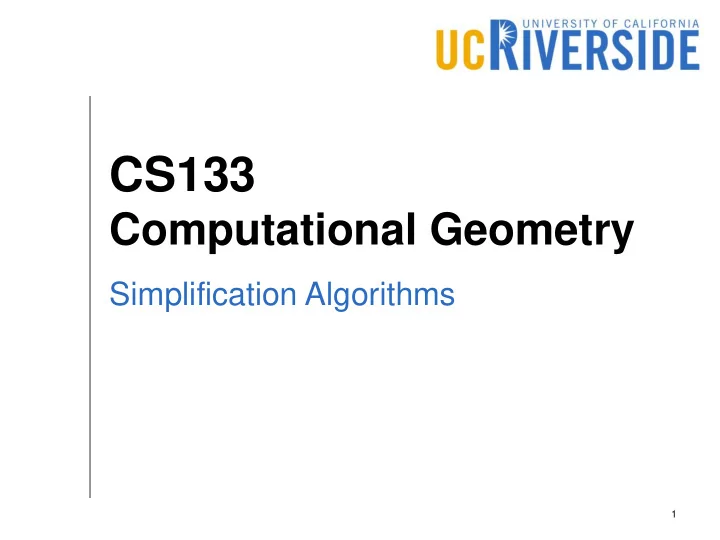

CS133 Computational Geometry Simplification Algorithms 1
Line Simplification ? 2
Line Simplification Given a line string and a distance threshold 𝜁 , return a simplified line string such that any point in the input line string is not displaced more than 𝜁 3
Douglas – Peucker Algorithm ≤ 𝜁 4
Douglas – Peucker Algorithm ≤ 𝜁 5
Douglas – Peucker Algorithm 6
Douglas – Peucker Algorithm ≤ 𝜁 7
Douglas – Peucker Algorithm ≤ 𝜁 8
Douglas – Peucker Algorithm ≤ 𝜁 9
Douglas – Peucker Algorithm ≤ 𝜁 10
Douglas – Peucker Algorithm 11
Douglas – Peucker Algorithm 12
Douglas – Peucker Algorithm 13
Running Time function DouglasPeucker(P[], 𝜁 ) // Find the point with the maximum distance (=maximum cross product) cmax = 0 index = 0 for i = 2 to ( end - 1) c = 𝑄 1 𝑄[𝑜] × 𝑄 1 𝑄[𝑗] if ( c > cmax ) 𝑈 𝑜 = 𝑈 𝑜1 + 𝑈 𝑜 − 𝑜1 + 𝑃 𝑜 index = i cmax = c if (cmax / 𝑄 1 [𝑄 𝑜 > 𝜁 ) { R1 = DouglasPeucker(P[1..index], 𝜁 ) R2 = DouglasPeucker(P[index..n], 𝜁 ) R1.removeLast return R1 || R2 // Concatenate the two lists else return [P[1], P[n]] // Only return the first and last points 14
Polygon Triangulation 15
Polygon Triangulation Given a simple polygon P, break it down into a set of triangles 𝑈 such that the union of the triangles is equal to the polygon and no two triangles intersect. That is: ڂ 𝑢 𝑗 ∈𝑈 𝑢 𝑗 = 𝑄 and 𝑢 𝑗 ∩ 𝑢 𝑘 = 𝜚 for any 𝑢 𝑗 , 𝑢 𝑘 ∈ 𝑈 and 𝑗 ≠ 𝑘 16
Polygon Triangulation 17
Convex Polygons Choose any vertex on the polygon Connect it to all other vertices to create all diagonals Number of possible triangulations is Catalan Number 𝐷 𝑜−2 2𝑜 1 2𝑜! 𝐷 𝑜 = = 𝑜 𝑜+1 𝑜+1 !𝑜! 18 By Eric Détrez (as published at www.texample.net in 2008-10-09) - The image is the result of a latex script example published at [1]. All the site is under CC-2.5-by license, as seen on every page of the wite., CC BY 2.5, https://commons.wikimedia.org/w/index.php?curid=56872963
Number of Triangles Number of triangles in a triangulation of a polygon of 𝑜 points is 𝑜 − 2 triangles Can be proven by induction Trivial case: 𝑜 = 3 General case: If it applies for all 𝑜 < 𝑛 , we need to prove that it applies for 𝑜 = 𝑛 That is, we want to prove that if a triangulation exists, it will have 𝑛 − 2 triangles 19
Induction 𝑜 1 𝑜 2 𝑜 1 + 𝑜 2 = 𝑛 + 1 # of triangles in 𝑄 1 = 𝑜 1 − 2 , in 𝑄 2 = 𝑜 2 − 2 # of triangles in 𝑄 = 𝑜 1 − 2 + 𝑜 2 − 2 + 1 = 𝑜 1 + 𝑜 2 − 4 + 1 = 𝑛 + 1 − 4 + 1 = 𝑛 − 2 20
Existence of a Triangulation Any simple polygon has at least one triangulation Proof by induction Trivial case: 𝑜 = 3 General case: If there are triangulations for all polygons 𝑜 < 𝑛 , we need to prove that there is one for 𝑜 = 𝑛 21
Induction 22
Dual Graph Dual graph Each triangle is represented by a vertex in Two triangles that share an edge are connected by an edge in 23
Recommend
More recommend